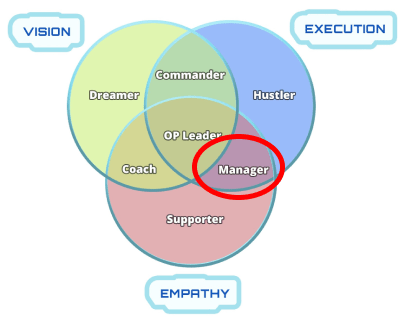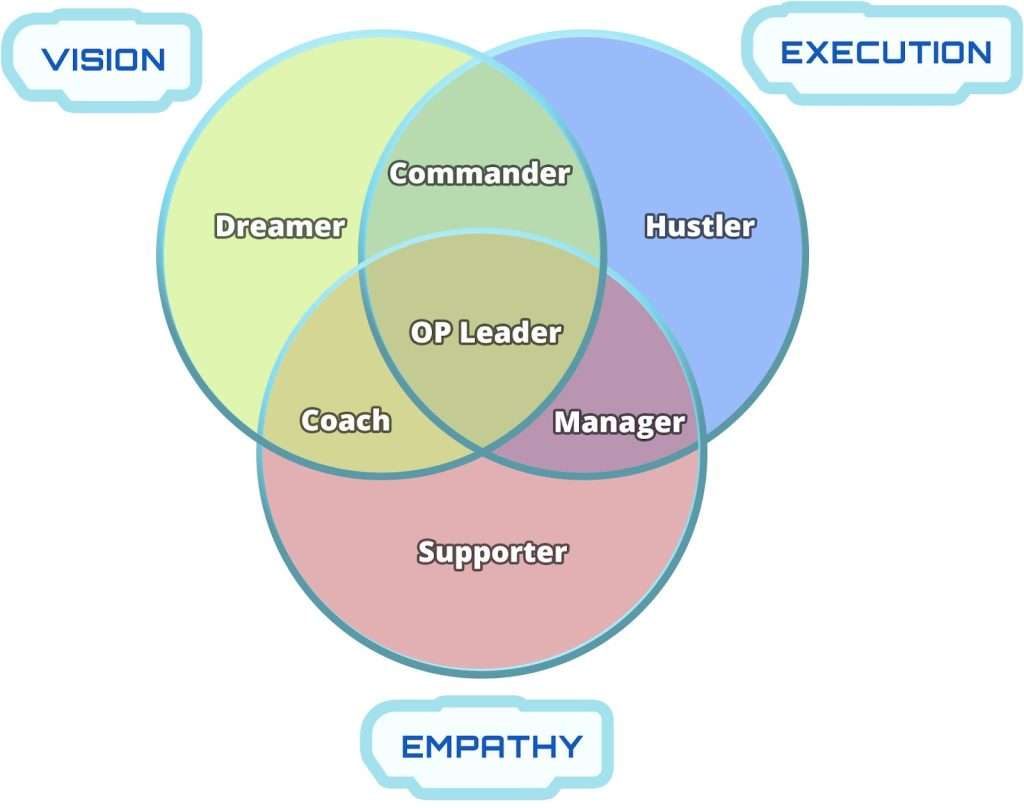OP Leadership Attributes of 10K HP
Developing leadership through the three OP Attributes—Vision, Empathy, and Execution—is essential for achieving leadership excellence. These attributes, seen in some of the world’s most successful leaders, will dramatically enhance your ability to guide teams toward success.
The Three Key Leadership Attributes
The most effective leaders possess a powerful combination of Vision, Empathy, and Execution. These “OP” (overpowered) Leadership Attributes enable leaders to thrive in complex environments and lead their teams to victory.
1. Vision: The Power of Seeing Ahead

Visionary leaders have the ability to see where their team stands today and also where they need to go in the future. This involves:
- Seeing the big picture.
- Envisioning a brighter future.
- Realistically assessing the feasibility of that path.
- Communicating that vision to the team with conviction.
Without a clear vision, teams often lose themselves in day-to-day tasks, missing out on opportunities for meaningful progress. Elon Musk is a prime example of an individual whose vision fueled groundbreaking innovations.
2. Empathy: Understanding Your Team

Knowing where to go is essential, but understanding your team’s emotions and motivations is equally important. Empathy enables leaders to maintain morale, foster collaboration, and cultivate a positive workplace culture.
Without empathy, leaders risk losing the trust and support of their team, which can lead to a decline in morale and increased turnover. Legendary leaders like John Wooden, the renowned basketball coach, achieved success by building deep connections with his players, understanding that individual well-being is just as important as performance.
3. Execution: Turning Plans Into Reality

A great leader must be skilled in execution, transforming plans into action while ensuring accountability across the team. Without execution, even the most brilliant ideas remain unrealized. Leaders who prioritize execution bring visions to life by mobilizing their teams effectively.
Steve Jobs is a great example of an individual whose execution led to innovative products at its time, the iPhone Generation 1 in 2007. Before the iPhone, most smartphones relied on physical keyboards, like BlackBerry devices with clunky interfaces. The iPhone changed this by introducing a full touchscreen with multi-touch gestures, creating a fluid, intuitive interface that seamlessly integrated calling, messaging, music, photography, gaming, and web browsing.
Finding Balance: Personal Insights on Leadership
Reflecting on my own leadership journey, I’ve found my strengths in Vision and Empathy. Early on, I was attuned to my team’s emotions, which allowed me to create one of the most recognized human motivation frameworks. My ability to spot trends also helped me excel in areas like gamification and blockchain.
However, I faced challenges with Execution. My empathy sometimes made it difficult to push others to perform at their peak. While this worked well with self-driven, creative individuals, it proved less effective in disciplined environments. Over time, I learned to balance empathy with accountability. As a leader, failing to hold underperformers accountable can demoralize your top performers.
The Relentless Focus of Great Leaders
Consider Elon Musk as an example. After a failed rocket launch in 2008, Musk famously told his exhausted team, “Never. I don’t ever give up. I’d have to be dead or completely incapacitated. For my part, I will never give up, and I mean never.” He turned that defeat into motivation, demonstrating his unmatched ability to execute while keeping the team aligned with his vision. Similarly, Eiichiro Oda, creator of One Piece, exemplifies relentless focus on execution, often at personal sacrifice.
The Role of Execution in Morale
Winning is one of the most effective morale boosters. Teams that see their hard work result in world-changing achievements experience a deep sense of accomplishment. Conversely, working in a team that never achieves its goals, no matter how appreciated one feels, can be disheartening.
Learning to confront underperformance respectfully helped me improve my execution skills. By ensuring everyone is accountable, you create an environment where driven individuals thrive.
Turning Weaknesses into Strengths
Through self-awareness, I leveraged my strengths in Empathy to enhance my Execution skills. Rather than forcefully overcoming my weaknesses, I used my natural talents to support growth in areas where I was less proficient. This is a key insight for leaders: maximize your strengths while steadily improving your weaknesses.
By focusing on Vision, Empathy, and Execution, you can evolve into a leader who inspires, connects, and delivers—traits that define true leadership success.
10K HP Team Player Types
Discover the 7 Key 10K HP Team Player Types: Unleashing Your Leadership Potential
In any high-performing team, individuals contribute unique strengths that drive overall success. Drawing from the core leadership attributes of Vision, Empathy, and Execution, we can identify seven distinct 10K HP Team Player Types. While each type brings valuable qualities, these are considered team roles rather than leadership roles when an individual embodies only one of the three attributes. Let’s take a closer look at these types and their role in fostering effective team dynamics.
The Seven 10K HP Team Player Types
- The Dreamer
- The Supporter
- The Hustler
- The Coach
- The Commander
- The Manager
- The OP Leader
1. The Dreamer (Vision Only)

Dreamers have a clear vision of what the future could be. They can imagine possibilities and see ways to improve things, but they often lack the drive or execution to bring their ideas to life. You may know someone who speaks passionately about their ideas but rarely takes action—these are the Dreamers.
Although Dreamers may sometimes step back from direct leadership roles, their visionary insights have the potential to inspire a brighter future. They can excel as thought leaders, advisors, or strategists—positions where they focus on ideas while others handle execution. Roles such as ethicists, scholars, or strategists are a natural fit. To thrive, Dreamers can develop skills like public speaking, writing, or personal branding to effectively share their vision with the world.
2. The Supporter (Empathy Only)

Supporters are the backbone of any team, excelling at understanding others and creating a positive, nurturing environment. They help team members feel valued, making them essential for building morale and fostering collaboration. However, when placed in leadership roles, Supporters may struggle with setting a clear vision or driving the team toward action.
Roles like counseling, teaching, or caregiving align well with the Supporter’s empathetic strengths. If you identify primarily as a Supporter, it’s beneficial to focus on skills that enhance your natural ability to connect with others, such as rapport-building and empathetic communication. Empathy is essential for fostering team harmony and keeping members motivated, even though it may not directly drive immediate results.
3. The Hustler (Execution Only)

Hustlers are known for being action-oriented and focused on results. They thrive in fast-paced environments where tasks need to be completed quickly and efficiently. However, their intense drive can sometimes come at the expense of empathy and long-term vision, which may cause friction with teammates or lead to a lack of strategic direction.
Their relentless work ethic can certainly push teams forward, but Hustlers benefit from having a clear roadmap to channel their energy more effectively. They tend to excel in fields like sales or entrepreneurship, where success often depends on immediate outcomes. To grow as well-rounded leaders, Hustlers should aim to cultivate qualities like empathy and long-term vision, enhancing their ability to lead with greater balance and foresight.
4. The Coach (Vision + Empathy)

Coaches bring together Vision and Empathy, leading teams with clear direction while keeping morale high. They have a natural talent for inspiring others and making sure everyone feels supported. However, Coaches may find it challenging to handle execution on their own, so they often need strong Hustlers or Managers to help bring their vision to life.
Coach-style leaders excel in environments that prioritize creativity and emotional well-being, such as wellness centers, educational institutions, and creative agencies. By nurturing intrinsic motivation, Coaches can spark innovation and effective problem-solving, enabling their teams to achieve remarkable results in the right settings.
5. The Commander (Vision + Execution)

Commanders are driven by a strong vision and the ability to bring that vision to life. They are decisive and results-oriented, but often lack empathy, which can lead to a leadership style that pushes people hard without fully considering their emotional well-being. As a result, Commanders’ leadership can sometimes come across as harsh or unyielding.
While Commanders have the potential to lead teams to extraordinary success, they need to balance their approach to avoid burnout and high turnover. Leaders like Steve Jobs and Elon Musk exemplify this style, often pushing their teams to the edge yet achieving groundbreaking results.
6. The Manager (Execution + Empathy)

Managers, on the other hand, excel at keeping operations running smoothly. They are attuned to their team’s emotional needs and are highly effective at executing tasks, ensuring everything is done efficiently and on schedule. However, they may not always have the visionary leadership required to drive long-term strategic growth.
In organizations where immediate tasks need to be accomplished, Managers are indispensable. When paired with strong visionary leaders, they can help transform ideas into reality while fostering a positive and productive team environment.
7. The OP Leader: Mastering Vision, Empathy, and Execution

Becoming an OP Leader represents the pinnacle of leadership, demanding a seamless balance of three essential 10K HP Leadership Attributes: Vision, Empathy, and Execution. This powerful combination enables leaders to inspire teams, build meaningful connections, and deliver results with precision.
The Three Pillars of OP Leadership
1. Vision: Guiding with Purpose
An OP Leader possesses a clear grasp of their goals and the strategies needed to achieve them. They excel at transforming ideas into actionable plans, setting ambitious objectives, and motivating their team to embrace a shared vision. By consistently communicating this vision, OP Leaders keep their teams aligned, inspired, and focused on long-term success.
2. Empathy: Building Trust and Connection
Empathy is the foundation of OP Leadership. These leaders genuinely care about their team members, understanding their emotions, motivations, and concerns. By fostering a supportive environment, they cultivate trust and loyalty, leading to a deeply engaged and committed team. This emotional intelligence helps them navigate challenges with compassion, maintaining high morale even in tough situations.
3. Execution: Delivering Results with Discipline
OP Leaders are visionaries who know how to get things done effectively and with great empathy. Their strength lies in balancing empathy with decisive action, driving their teams toward tangible results. Whether it’s meeting deadlines or making tough decisions, they turn vision into reality through disciplined execution. They understand when to push their team and when to offer support, creating a balanced approach that consistently ensures success.
Why OP Leadership is So Effective
An OP Leader fosters an environment where people are motivated to contribute and thrive. Their unique combination of care and effectiveness ensures that goals are met in an atmosphere of respect and empowerment. The clarity of their vision serves as a guiding star, helping the team navigate obstacles while maintaining a positive and focused outlook.
A key trait of an OP Leader is their ability to view challenges as opportunities for growth. They maintain team morale during difficult times, seeing setbacks as moments to learn and improve. This balanced approach keeps everyone motivated and aligned with the broader mission, making the journey to success smoother and more fulfilling for all involved.
The Rarity of True OP Leaders
Becoming an OP Leader is no easy feat. Historically, few individuals achieve mastery in all three leadership attributes—Vision, Empathy, and Execution. Most leaders excel in two of the three and spend their careers developing the third. Unlike skills, which can be quickly learned or refined (as outlined in Step 4 of the 10K HP framework), these core attributes take years to fully develop. This is what makes true OP Leaders so rare and revered.
Historical figures who exemplified OP Leadership include Winston Churchill, Eleanor Roosevelt, Angela Merkel, and Sun Yat-sen. These leaders had a clear vision for their countries and causes, effectively balancing empathy and execution, which allowed them to guide their nations through some of history’s most challenging periods.
OP Leadership as a Beacon for Success
Embracing OP Leadership allows individuals to navigate both personal and professional challenges with greater resilience and foresight. Their balanced approach attracts mentors, collaborators, and supporters who are eager to contribute to their vision. Over time, their leadership becomes a beacon, drawing success, teamwork, and shared achievements. By mastering Vision, Empathy, and Execution, OP Leaders create a legacy of inspiration, growth, and lasting impact.








